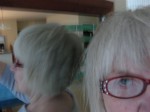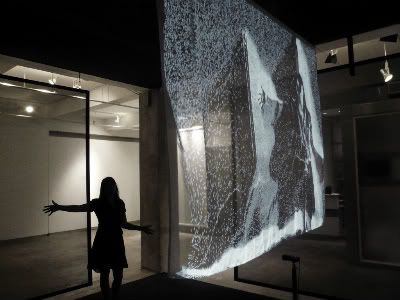Stranger in a strange land
By Judith Ann Moriarty
Now – January 11, 2009
I’m bound to the past. I approach the very idea of “interactive” art with a wary eye. To view a painting, sculpture or photograph is a personal event shaped by my education in the arts and my philosophy of what art is. I enjoy being pleased by the sublime. Joining the masses headed for the next big thing is not my idea of a great art experience.
So I asked myself, “Is interactive art a passing fancy or a fancy pass?” It’s certainly not a new form of expression. It’s been around for at least half of my seven decades on earth. As a kid I touched on it (marginally) when I sat in bed with a flashlight and used my fist and a few digits to cast shadow “animals” on the wall. Maybe that was more generative than interactive, but it came close.
And so it was that I spent hours entering and exiting the Baker/Rowland galleries, attending lectures, panels and gallery talks. I studied the online history of the interface. I slogged through virtual games, ‘60s Happenings and video art and learned that the computer-controlled IA idea began in 1969 with Glowflow, a space with pressure-sensitive sensors on its floor, loudspeakers in the four corners of the room and tubes with colored suspensions on the wall. As the movement gained speed, artists Robert Rauschenberg and James Seawright latched on to the moveable sensory feast. The Museum’s Sensory Overload, with Erwin Redl’s mathematical marvel, Matrix XV, 2007, Landsman’s Walk-In Infinity Chamber, 1968 and Sonic II, a wall-hung piece which reacts with noises to the presence of visitors, garnered mixed reviews, but the show set the stage for Act/React, which runs through January 11, 2009.
Here’s an excerpt from Katherine Murrell, co-publisher of susceptibletoimages.com. Written for their June 11, 2008 issue, it speaks to at least some of my wariness about IA:
“The quest for interactivity is one that seems to be on the mind of many cultural institutions. With a society so accustomed to being entertained, to having sensory experience on-demand and in all forms, whether it be the high definition DVD on the giganto plasma screen or Lawrence of Arabia squashed down to fit your cell phone, we usurp images into our medium of choosing within the informal context of our lives.”
Daniel Keegan, the new executive director of MAM, more or less concurs when he says the museum is “perpetually searching for new ways to engage our audience.” Call it entertainment (or engagement) – a new generation attached to high-technology wants it all and wants it now.
The six artists participating in Act/React aren’t wet behind the ears. Several of them have been involved in IA for the past decade, and one of them (Liz Phillips) has been at it for 39 years. During my second visit to the exhibit, Ms. Phillips’ installation, Echo Evolution, 1999, was having a few technical problems, but even with the glitches it’s clear that the enclosed space is an intriguing laboratory.
Boundary Functions, 1998 and Deep Walls, 2003 (both by Scott Snibbe) introduce the show, and the pair is a great introduction to what waits beyond. I explored the former (it takes two, or more, to get it going) and discovered that “my space,” defined by lines projected from above, dissolved when (after asking for permission) I gingerly touched the person nearest to me. Deep Walls reminds me of the opening graphics in television’s Mad Men, and further back than that, the early ‘80s paintings of Robert Longo, whose depictions of black-suited men plummeting earthward I initially saw at MAM. When given the green light, visitors are as unfettered as kids, whirling, jumping, leaping, coming and going, their shadowy images captured on projected grids. I joined in to become a temporary part of the big scrapbook.
Brian Knep’s Healing Pool #1, 2003 is a visual wash of organic forms projected onto the floor. A woman standing near me insisted the forms originated underneath the vinyl floor, and was startled when I pointed to the overhead source consisting of custom software, video projectors and video cameras. I’d fallen into the same trap earlier when I asked Knep how the floor and all of its colors were shipped to the museum. “It’s not about the floor,” he said (patiently) while pointing upward.
Snow Mirror (Daniel Rozin) is Goth redefined. Pixeled images of visitors evaporate, ghostly, as if being carried off by the colder-than-ice Snow Queen projected onto silk. There is an oriental aura here, something akin to Mishima’s novel Spring Snow, where time ultimately crushes the physical. His Peg Mirror is less frightening by far, but of the two works, I much prefer the ghostly. Three abstract painterly projections by Camille Utterback define the end point of the exhibit. She told me that one of her works is installed in a Tokyo hotel lobby, and yes, she has sold the concept to collectors. Comparisons are wearisome, but it’s clear that she’s been influenced by the likes of Jackson Pollack, Joan Mitchell and other painters of the abstract expressionist ilk. I hate to admit it, but even at this point in the exhibit, I found myself checking the wall to see what kind of stretchers she used. Old habits die hard.
But where does “beauty” fit in? When I stand before a sublimely painted landscape, an elegant sculpture or photograph, I’m aware that the work is an illusion filtered through the mind of the artist. If my experience is delicious, I’m thrilled. In his glorious book Let’s See, New Yorker magazine art critic Peter Schjeldahl has this to say about “beauty”:
“Beauty is not a concept. To begin with, it is a common word, defined in a dictionary as “the quality present in a thing or person that gives intense pleasure or deep satisfaction to the mind …” Beauty harmonizes consciousness from top to bottom. It is as organically vital as digestion. Beauty is, or ought to be no big deal, though the lack of it is.”
Act/React does not lack for beauty. It’s tempting to compare it to The Wizard of Oz, which ultimately (when the fog clears) defrocks the Wizard and reveals him to be an ordinary man pushing levers and gears. In the September 15, 2008 issue of The New Yorker, pop music critic Sasha Frere-Jones muses about a contemporary musician who uses only a laptop onstage. He asks the question, “There is no longer anyway of telling whether or not the Wizard is behind the curtain. Does it matter?”
The six “wizard/artists” behind Act/React would likely say it doesn’t. I asked George Fifield, a former Milwaukeean who guest-curated the brainy exhibit, to define “beauty.” He told me, “Beauty is that which is pleasantly unexpected.”
Having fought the very idea of interactive art, frankly, I expected not much at all. What a fool. The exhibit is so smartly installed (with room to breathe and space to think) that I exited in fine spirits, feeling at least marginally informed about what’s behind all those levers and gears. You needn’t fret about understanding the technology pumping Act/React. Nerd or not, you’ll discover beauty aplenty on the walls and on the floors and in the darkened enclosed rooms. Lest you forget, it’s the inquiring minds of the artists who brought it to fruition.
I ended my visit in the Baumgartner east wing, pausing a moment to consider the day’s experience. As I gazed at the lake, the glassy windows caught the reflection of a segment of the Brise wings unfurling overhead. VS


















